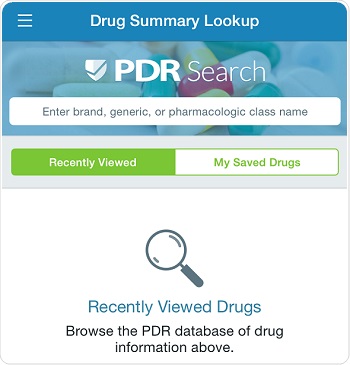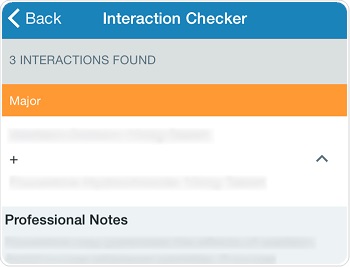The incidence of drug interactions and adverse effects continues to increase due to the rise of multi-drug administration and the aging population in developed nations.

Elderly patient looking at prescription bottles © Martin Haas / Shutterstock.com
Up to 10% of all hospital admissions result from drug-related problems and half of these cases could be prevented with adequate medical advice and care. This affects elderly populations, in particular, of whom approximately 80% suffer from one or more health conditions and take 14 to 18 prescriptions per year, on average.
Given the vast number of prescription and over-the-counter (OTC) medications in use, it can be difficult for healthcare professionals to identify possible interactions between multiple drugs promptly. Additionally, many patients may not be clear about which pill contains which medication, leading to medication errors with potentially serious consequences as a result.
The mobilePDR app*
The Physicians’ Desk Reference (PDR) has been a trusted source of information for generations of health practitioners. Continuing to meet the needs of professionals working in the healthcare sector, the user-friendly mobilePDR app* can help to reduce the risk of adverse drug combinations and improve overall health outcomes.

*App only intended for US Healthcare Professionals
The app* provides users with access to an extensive database of drug summaries for FDA-approved and OTC drugs which are regularly reviewed by PDR’s team of PharmD clinicians to ensure the information is current and credible.
Two of the app’s easy-to-use features allow health professionals to quickly detect and prevent drug interactions, and easily identify unlabeled pills, capsules and tablets. With these key pieces of information available at their fingertips on their phone or tablet in any care setting, health professionals can arm themselves with knowledge to improve outcomes for patients.
Drug Interaction Checker
The ability to quickly check for interactions between several drugs at once is straightforward with the mobilePDR app* and particularly useful when a new drug is added to a patient’s medicine regime.

Simply add the relevant medications into the interaction checker and the app automatically identifies any potential problems in a matter of seconds. The app recognizes interactions that may occur between two or more medications, including both prescription and OTC drugs. This is particularly useful for complicated regimes or to detect issues between more drugs in less time.
Drug interactions are classified as severe, major, moderate or mild and can quickly be identified at a glance with the intuitive color-coding system. If there is a potential problem, simply tap on the interaction to find out more information and access advice about how to adjust the combination to improve patient outcomes.
Example Case Study:
Many patients take medications long-term, for months or years to treat some illnesses or for the rest of their lives to manage chronic conditions. When these patients present symptoms of a new acute disorder, it’s necessary to know whether the prescribed medication will cause adverse interactions with the medication already being taken.
With the mobilePDR app*, it is easy to input all the patient’s medications, including the drug(s) that the healthcare professional would like to prescribe for the acute condition. The app instantly alerting the healthcare professional to any potential issues, and providing details about how or why the drugs interact. This information allows the healthcare professional to make different treatment decisions, if necessary.
Pill Identification
If patients do not have an organized method for sorting and storing medications it can be easy to become confused, especially if taking multiple drugs at different times of day. This can lead to simple mistakes with severe consequences, such as taking a pill at the wrong time or dose.
For a health professional, such a mistake can be difficult to manage in an acute situation. The reaction can often be severe and require immediate attention but, without understanding which medications were involved in the case, it can be difficult to decide on an appropriate course of action.
The mobilePDR app* has a specialized feature that can help users recognize a particular medication by entering known details about the appearance of unlabeled pills, tablets, and capsules.

After inputting characteristics including the shape, color, size, scoring or imprint, the app will quickly bring up the most likely possibilities from the extensive built-in database. Full-color photos of the pill help to visually confirm that the correct match has been found.
Example Case Study:
A patient presents with a suspected adverse drug reaction, but the medical history shows several drugs taken regularly and it is unclear which medication is responsible for the effect.
The patient is unsure of the names of the pills taken that morning, but can describe what the pills looked like. Entering those details into the mobilePDR app* helps to identify a moderate interaction and provides key information that informs the health professional’s choices on adjusting the medications and alleviating the patient’s discomfort.
Reducing Risk of Adverse Drug Combinations
The mobilePDR app* plays a key role in reducing the risk of adverse drug combinations for patients by providing a drug interaction checker and a pill identification tool. mobilePDR is a free application offered to health professionals based in the United States.
Adverse drug combinations are a common occurrence for today’s population and it is essential that health professionals are equipped with reliable information that is quick and easy to access in order to manage these events States to improve overall patient outcomes.
Sources
- http://www.sciencedirect.com/science/article/pii/S1319016413000509
- https://www.ascp.com/
- http://www.pdr.net/resources/mobilePDR/
- http://www.imedicalapps.com/2015/09/mobilepdr-medical-app-iphone-android-review/
- http://www.businesswire.com/news/home/20150811006004/en/Introducing-mobilePDR%C2%AE-official-drug-information-comparison-app#.Vg6ocflVikq
*App only intended for US Healthcare Professionals
About Physicians' Desk Reference (PDR)

Trusted by generations of healthcare providers, PDR delivers innovative health knowledge products and services that support prescribing decisions and patient adherence to improve health.
As a leading provider of behavior-based prescription management programs, PDR provides event-driven and clinically relevant healthcare messaging through its patented process that improves patient compliance and outcomes, while preserving privacy.
This network is made up of e-prescribing, electronic medical record (EMR), and electronic health record (EHR) applications, chain and independent pharmacies, and sponsors of healthcare-related education such as pharmaceutical manufacturers, health plans, payers, and pharmacy benefit managers.
The Physicians' Desk Reference® suite of services provides healthcare professionals multichannel access to important drug information: the PDR®, the most recognized drug information reference available in the U.S.; interactive drug information services for EHR/EMR systems; digital communication services; PDR.net®; and mobilePDR®
Sponsored Content Policy: News-Medical.net publishes articles and related content that may be derived from sources where we have existing commercial relationships, provided such content adds value to the core editorial ethos of News-Medical.Net which is to educate and inform site visitors interested in medical research, science, medical devices and treatments.